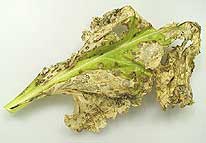|
ARS News Service
Agricultural Research Service, USDA
Don Comis, (301) 504-1625,
comis@ars.usda.gov
May 21, 2003
Agricultural Research Service
scientists have applied for a patent on their discovery of a
"good" fungal enzyme that may prevent leaf spot, a
widespread disease of sugar beets that reduces beet yields
and sugar content.
This biocontrol discovery is especially timely because
scientists now believe thatCercospora beticola, the fungus
that causes leaf spot disease, is beginning to develop
resistance to some fungicides. The researchers envision
possibly applying some form of the enzyme to sugar beet
leaves to starve the "bad" fungus.
In 2001, U.S. farmers grew
more than 25 million tons of sugar beets, providing about
half of the country's sugar supply. They also applied
thousands of pounds of fungicide to sugar beet leaves to
battle leaf spot. |
 |
|
Cercospora
leaf spot disease symptoms
on a sugar beet leaf.
Photo by ARS Northern Plains Ag. Res. Lab, Sidney, MT.
|
Plant pathologist Robert Lartey
and microbiologist TheCan Caesar-TonThat of ARS' Northern Plains
Agricultural Research Laboratory in Sidney, Mont., discovered an
enzyme called laccase in the beneficial fungus Laetisaria
arvalis. This fungus is well known as a wood- and leaf-decay
fungus of forests. But it is also found in farm soils where
sugar beets grow.
Laccase is one of many enzymes produced by the fungus to break
down deadwood and leaves. In lab experiments, it was very good
at detoxifying the toxin produced by the leaf spot fungus. The
toxin, called cercosporin, kills plant leaf cells. Leaf spot
gets its name from the spots on leaves that are actually
colonies of fungi feeding on leaf tissue killed by the toxin.
Next, Lartey and Caesar-TonThat will test the enzyme on potted
sugar beet plants in a greenhouse. If that goes well, they will
move on to sugar beets growing in the field.
More information about this natural biocontrol research can be
found in the May issue of Agricultural Research magazine.
ARS is the U.S. Department of Agriculture's chief scientific
research agency.
Cura natural posible para la mancha de la
hoja de la remolacha azucarera
Servicio Noticiero del Servicio de Investigación Agrícola (ARS
siglas en inglés)
Departamento de Agricultura (USDA siglas en inglés)
Don Comis, (301) 504-1625,
comis@ars.usda.gov
21 de mayo 2003
Científicos del Servicio de Investigación Agrícola (ARS) han
aplicado para una patente sobre el descubrimiento de una enzima
fungal 'buena' que podría prevenir la mancha de la hoja, una
enfermedad extendida de la remolacha azucarera que reduce
rendimientos y contenido de azúcar.
Este descubrimiento de biocontrol es especialmente oportuno
porque los científicos ahora creen que 'Cercospora beticola', el
hongo que causa la enfermedad de la mancha de la hoja, está
comenzando a desarrollar resistencia a algunos fungicidas. Los
investigadores imaginan que será posible aplicar alguna forma de
la enzima a las hojas de remolacha azucarera para hambrear el
hongo 'malo'.
En el año 2001, los granjeros de EE.UU. cultivaron más de 25
millones de toneladas de remolacha azucarera, proveyendo como la
mitad del suministro de azúcar de este país. Ellos también
aplicaron miles de libras de fungicida a las hojas de la
remolacha azucarera para combatir las manchas de la hoja.
Patólogo de planta Robert Lartey y microbióloga TheCan
Caesar-Ton That del ARS en el Laboratorio de Investigación
Agrícola de los Llanos Norteños en Sidney, Montana, descubrieron
una enzima llamada laccase en el hongo beneficioso 'Laetisaria
arvalis'. Este hongo es bien conocido por su habilidad de
descomponer madera y hojas en los bosques. Pero también se
encuentra en los suelos de granjas donde crece la remolacha
azucarera.
Laccase es una de muchas enzimas producidas por el hongo para
descomponer madera muerta y hojas. En experimentos de
laboratorio, laccase funcionó muy bien para desintoxicar la
toxina producida por el hongo de la mancha de la hoja. La
toxina, llamada 'cercosporin', mata las células de la hoja de
planta. La mancha de la hoja recibe su nombre por las manchas en
las hojas que en realidad son colonias de hongo alimentandose en
el tejido de la hoja matado por la toxina.
Luego, Lartey y Caesar-Ton That ensayarán la enzima en las
plantas de remolacha azucarera en macetas en un invernadero. Si
esto sale bien, ellos comenzarán con la remolacha azucarera
creciendo en el campo.
Más información sobre esta investigación de biocontrol natural
se puede encontrar en la revista 'Agricultural Research' de mayo
y en Internet en:
http://www.ars.usda.gov/is/AR/archive/may03/beet0503.htm
ARS es la agencia principal de investigaciones científicas del
Departamento de Agricultura de EE.UU.
|